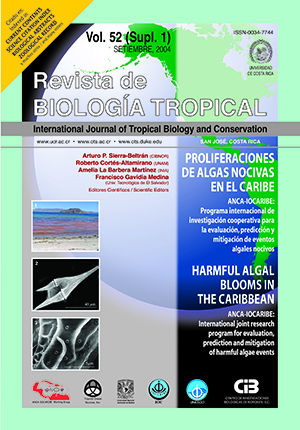Resumen
Pruebas de ciguatoxicidad en la gran barracuda, Sphyraena barracuda y la cantidad de dinoflagelados bentónicos tóxicos en los arrecifes de la costa están correlacionados con el número de casos de intoxicaciones por ciguatera en humanos, en Puerto Rico. Estos hechos fueron utilizados para construir un modelo que fue formulado con la información recopilada durante el período de 1985- 1988. La validez de este modelo propuesto ha sido cuestionada debido a la información recientemente obtenida durante el período 1990-2000. La ciguatoxicidad en la barracuda ya no demostraba una marcada asociación con las temporadas mientras que la cantidad de barracuda ciguatóxica capturada al azar tuvo un aumento significativo durante este período. Estos dos cambios estuvieron acompañados por el descubrimiento de que peces ciguatóxicos contienen una gran variedad de toxinas que parecen estar relacionadas con los períodos de elevadas temperaturas en la superficie del mar. Estas temperaturas continúan aumentando de manera que a su vez continúan en un aumento estable en esta región.Citas
Ashton, M., T. Tosteson & C. Tosteson. 2003. The effect of elevated temperature on the toxicity of the laboratory cultured dinoflagellate Ostreopsis lenticularis (Dinophyceae). Rev. Biol. Trop. 51 (Supl. 6): 1-6.
Ballantine, D.L., T.R. Tosteson, H.D. Durst & A.T. Bardales. 1988. Population dynamics and toxicity of natural populations of benthic dinoflagellates in southwest Puerto Rico. J. Exp. Mar. Biol. Ecol. 119: 201-212.
Beddow, T.A., J.L. Van Leeuwen & I.A. Johnson. 1995. Swimming kinematics of fast starts are altered by temperature acclimation in the marine fish Myoxocephalus scorpius. J. Exp. Biol. 198: 203-208.
Halstead, B.W. 1967. Poisonous and Venomous Marine Animals of the World. U.S. Government Printing Office. Washington D.C.
Legrand, A.M., M. Fukui, P. Cruchet, Y. Ishibashi & Y. Yasumoto. 1992. Characterization of ciguatoxins from different fish species and wild Gambierdiscus toxicus, pp. 25-32. In T.R. Tosteson (ed.). Proc. Third Inter. Conf. Cigua. Fish Poisoning, Polyscience Publications Inc., Quebec, Canada.
Lewis, N.I., S.S. Bates, J.L. McLachlan & J.C. Smith. 1993. Temperature effects on growth, domoic acid production, and morphology of the diatom Nitzschia pungens f. multiseries, pp. 601-606. In T.J. Smayda & Y. Shimizu (eds.). Toxic Phytoplankton Blooms in the Sea, Elsevier, New York.
Lewis R.J., M. Sellin, M.A. Poli, R.S. Norton, J.K. MacLeod & M.M. Sheil. 1991. Purification and characterization of ciguatoxins from moray eel (Lycodontis javanicus, Muraenidae). Toxicon 29: 1115-1127.
Oshima, Y., H. Itakura, K.-C. Lee, T. Yasumoto, S. Blackburn & G. Hallegraff. 1993. Toxin production by the dinoflagellate Gymnodinium catenatum, pp. 907-912. In T.J. Smayda & Y. Shimizu (eds.). Toxic Phytoplankton Blooms in the Sea, Elsevier, New York.
Pitcher, G.C., D.A. Horstman & D. Calder. 1993. Formation and decay of red tide blooms in the southern Benguela upwelling system during the summer of 1990/91, pp. 317-322. In T. J. Smayda and & Y. Shimizu (eds.). Toxic Phytoplankton Blooms in the Sea. Elsevier, New York.
Pottier, I., J.P. Vernoux, A. Jones & R.J. Lewis. 2002. Characterization of multiple Caribbean ciguatoxins and congeners in individual specimens of horse-eye jack (Caranx latus) by high performance liquid chromatography/ mass spectrometry. Toxicon 40: 929-940.
Senthilkumaran, B. & K.P. Joy. 1995. Changes in hypothalamic catecholamines, dopamine-beta- hydroxylase, and phenylethanolamine-N-methyl transferase in the catfish Heteropneustes fossilis in relation to season, raised photoperiod and temperature, ovariectomy and estradiol-17-beta replacement. Gen. Comp. Endocrin. 97: 121-134.
Tosteson, T.R., D.L. Ballantine & H.D. Durst. 1988. Ciguatoxic barracuda frequency in southwest Puerto Rico. Toxicon 26: 795-801.
Tosteson, T.R., D.L. Ballantine, C.G. Tosteson, V. Hensley & J. Bardales. 1989. Associated bacterial flora, culture growth and toxicity of the benthic dinoflagellates, Ostreopsis lenticularis and Gambierdiscus toxicus. J. Appl. Environ. Microbiol. 55: 137-141.
Tosteson, T.R., R.A. Edwards & D.G. Baden. 1992. Caribbean ciguatera and polyether dinoflagellate toxins: Correlation of ciguatoxin with standard toxins. pp. 89-102. In T.R. Tosteson (ed.). Proc. Third Inter. Conf. Cigua. Fish Poisoning. Polyscience Publications Inc., Quebec, Canada.
Tosteson, T.R. 1995. The diversity and origins of toxins in ciguatera fish poisoning. P.R. Health Sci. J. 14: 117-129.
Tosteson, T.R., R.F. Bard, I.M. Gonzalez, D.L. Ballantine & G.S. Bignami. 1995. Toxin Diversity in the Ciguatera Food Chain, pp. 73-87. In Y. Hokama, P.J. Scheuer & T.Y. Takeshi (eds.). Proceedings of the International Symposium on Ciguatera and Marine Natural Products Asian Pacific Research Foundation, Honolulu, Hawaii.
Tosteson, T.R., D.L. Ballantine & A. Winter. 1998. Sea surface temperature, Benthic dinoflagellate toxicity and toxin transmission in the ciguatera food chain, pp. 48-49. In B. Reguera, J. Blanco, M.L. Fernández & E. Wyatt (eds.). Harmful Algae. Xunta de Galicia, Spain, & IOC, UNESCO.
Comentarios

Esta obra está bajo una licencia internacional Creative Commons Atribución 4.0.
Derechos de autor 2004 Revista de Biología Tropical


